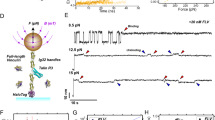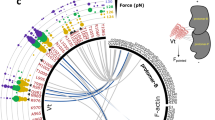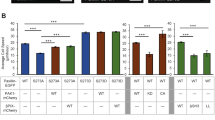Abstract
Vinexin is an adaptor protein supposed to play pivotal roles in various cellular events such as cell adhesion, cytoskeletal organization, signaling and gene expression. Despite the possible importance, physiological functions and regulatory mechanisms of vinexin are largely unknown. In addition, although vinexin was reported to be phosphorylated by extracellular signal-regulated kinase (ERK), physiological significance of the phosphorylation remains to be elucidated. Here we carried out characterization of endogenous vinexin and found that it was enriched at the leading edge of migrating cells and focal adhesions of spread cells. In the analyses using ERK-phosphorylated vinexin-specific antibody, the phosphorylation signal was also detected at the leading edges of migrating cells and at cell periphery of spreading cells, whereas only faint signal was observed at focal adhesions of well-spread cells. We then established LNCaP cell lines stably expressing GFP-fused vinexinβ or two mutants at Ser189 that mimic the ERK-phosphorylated or -unphosphorylated vinexinβ. Based on the analyses using the lines, the phosphorylation was likely to inhibit the cell spreading and migration. On the other hand, anchorage-independent cell growth was inhibited by unphosphorylated vinexinβ. Taken together, ERK-mediated phosphorylation of vinexinβ is strongly suggested to occur in a spatio-temporally regulated manner and play important roles in cell spreading, migration and anchorage-independent growth.
This is a preview of subscription content, access via your institution
Access options
Subscribe to this journal
Receive 50 print issues and online access
$259.00 per year
only $5.18 per issue
Buy this article
- Purchase on Springer Link
- Instant access to full article PDF
Prices may be subject to local taxes which are calculated during checkout









Similar content being viewed by others
References
Akamatsu M, Aota S, Suwa A, Ueda K, Amachi T, Yamada KM et al. (1999). Vinexin forms a signaling complex with Sos and modulates epidermal growth factor-induced c-Jun N-terminal kinase/stress-activated protein kinase activities. J Biol Chem 274: 35933–35937.
Bour G, Plassat JL, Bauer A, Lalevee S, Rochette-Egly C . (2005). Vinexinβ interacts with the non-phosphorylated AF-1 domain of retinoid receptorγ (RAR γ) and represses RAR γ-mediated transcription. J Biol Chem 280: 17027–17037.
Huang C, Jacobson K, Schaller MD . (2004). MAP kinases and cell migration. J Cell Sci 117: 4619–4628.
Ito H, Usuda N, Atsuzawa K, Iwamoto I, Sudo K, Katoh-Semba R et al. (2007). Phosphorylation by extracellular signal-regulated kinase of a multidomain adaptor protein, vinexin, at synapses. J Neurochem 100: 545–554.
Kioka N, Sakata S, Kawauchi T, Amachi T, Akiyama SK, Okazaki K et al. (1999). Vinexin: a novel vinculin-binding protein with multiple SH3 domains enhances actin cytoskeletal organization. J Cell Biol 144: 59–69.
Kioka N, Ueda K, Amachi T . (2002). Vinexin, CAP/ponsin, ArgBP2: a novel adaptor protein family regulating cytoskeletal organization and signal transduction. Cell Struct Funct 27: 1–7.
Matsuyama M, Mizusaki H, Shimono A, Mukai T, Okumura K, Abe K et al. (2005). A novel isoform of Vinexin, Vinexin gamma, regulates Sox9 gene expression through activation of MAPK cascade in mouse fetal gonad. Genes Cells 10: 421–434.
Mitsushima M, Sezaki T, Akahane R, Ueda K, Suetsugu S, Takenawa T et al. (2006). Protein kinase A-dependent increase in WAVE2 expression induced by the focal adhesion protein vinexin. Genes Cells 11: 281–292.
Mitsushima M, Suwa A, Amachi T, Ueda K, Kioka N . (2004). Extracellular signal-regulated kinase activated by epidermal growth factor and cell adhesion interacts with and phosphorylates vinexin. J Biol Chem 279: 34570–34577.
Nagata K, Asano T, Nozawa Y, Inagaki M . (2004). Biochemical and cell biological analyses of a mammalian septin complex, Sept7/9b/11. J Biol Chem 279: 55895–55904.
Suwa A, Mitsushima M, Ito T, Akamatsu M, Ueda K, Amachi T et al. (2002). Vinexin beta regulates the anchorage dependence of ERK2 activation stimulated by epidermal growth factor. J Biol Chem 277: 13053–13058.
Takahashi H, Mitsushima M, Okada N, Ito T, Aizawa S, Akahane R et al. (2005). Role of interaction with vinculin in recruitment of vinexins to focal adhesions. Biochem Biophys Res Commun 336: 239–246.
Tujague M, Thomsen JS, Mizuki K, Sadek CM, Gustafsson JA . (2004). The focal adhesion protein vinexin alpha regulates the phosphorylation and activity of estrogen receptor alpha. J Biol Chem 279: 9255–9263.
Acknowledgements
This work was supported in part by grants-in-aid for scientific research from Ministry of Education, Science, Technology, Sports and Culture of Japan, grants from Takeda Science Foundation and Aichi Cancer Research Foundation.
Author information
Authors and Affiliations
Corresponding author
Rights and permissions
About this article
Cite this article
Mizutani, K., Ito, H., Iwamoto, I. et al. Essential roles of ERK-mediated phosphorylation of vinexin in cell spreading, migration and anchorage-independent growth. Oncogene 26, 7122–7131 (2007). https://doi.org/10.1038/sj.onc.1210512
Received:
Revised:
Accepted:
Published:
Issue Date:
DOI: https://doi.org/10.1038/sj.onc.1210512
Keywords
This article is cited by
-
Cell biological characterization of a multidomain adaptor protein, ArgBP2, in epithelial NMuMG cells, and identification of a novel short isoform
Medical Molecular Morphology (2012)
-
Maggot excretions/secretions induces human microvascular endothelial cell migration through AKT1
Molecular Biology Reports (2010)
-
Interaction of a multi-domain adaptor protein, vinexin, with a Rho-effector, Rhotekin
Medical Molecular Morphology (2009)



